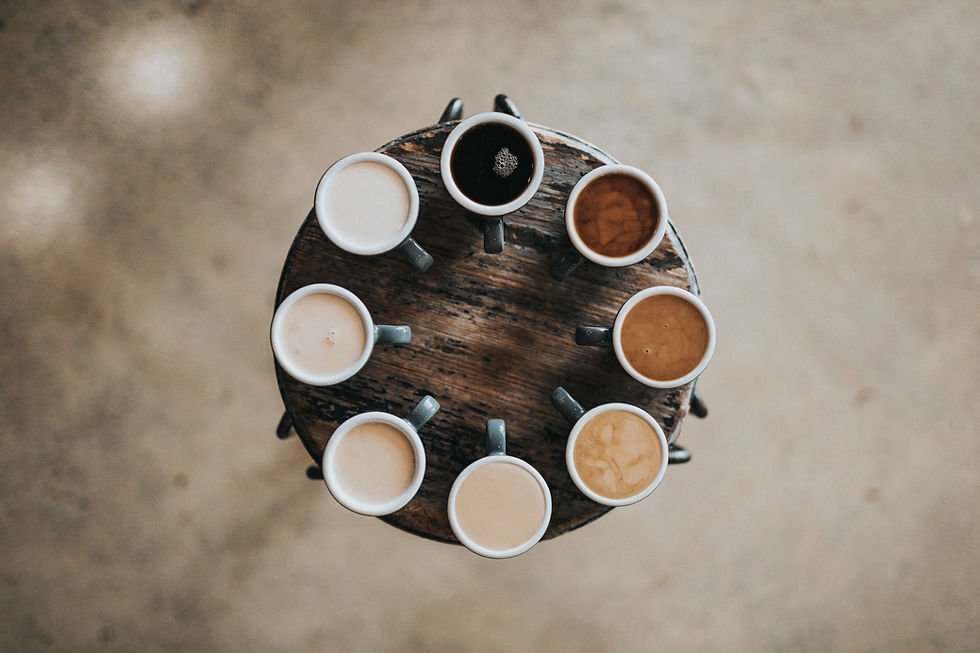Coffee Is Not Just Coffee: How To Taste
- Keith Lyons

- Mar 1
- 3 min read

Tasting coffee is something nearly anyone can learn to do, and is not only for coffee professionals. The trick is to practice by using comparative tastings and to taste different aspects of each coffee individually and as a whole. In the beginning, many people will take a sip (or slurp) of a nicely brewed coffee and become frustrated when they try to identify and describe various flavors and aspects of the coffee; acidity, sweetness, body, aroma, mouthfeel, etc. Below are a couple of tips on how to improve your ability to taste coffee in a meaningful way, which can help you find your favorite coffee as well as your favorite process of brewing that coffee.
Cupping and comparative tasting
Start by brewing at least two cups of coffee, which may vary by roast, bean, or brew type.
Only choose one aspect to change at a time. If you use the same bean then brew one as a pour over and one as an AeroPress, or brew two coffees the same but use two different origin beans of the relatively same roast level
Choose what aspect you want to compare and brew each cup only changing this aspect (brew type, roast level, dose, immersion vs. percolation, temperature, etc.)
You can increase this up to four or five different cups, but do not go too far beyond this or it can become overwhelming
Temperature
Let coffee cool before tasting, even re-doing your tasting at different temperature levels
Our sense of taste improves when we taste food or drink closer to body temperature, so allow the coffee to cool for tasting comparisons, even if you prefer a piping hot cup normally
The flavor of coffee changes as the temperature does, this is apparent if you brew a cup of coffee and taste it hot then allow it to chill in the fridge and taste again. It may be sweeter or more fruity, depending on the bean and roast
Stay Focused
Focus on one aspect of the coffee at a time, not the coffee as a whole
Focusing on the coffee one aspect at a time will improve your ability to hone in on different variables. You already know if a cup of coffee tastes good or bad, now you want to be able to pick out more specific descriptors, so focus on those
Use a tasting sheet and go through each cup considering only the aroma. Take notes, then go through each cup again repeating the process, but this time focusing only on acidity. Then sweetness, body, finish, etc.
This will help you to learn how to identify more specifics flavors and more easily identify the nuances in a cup of coffee that will ultimately help you to find your favorite cup
It’s rude not to slurp
You will often see seasoned professionals slurp when tasting, and you should too
Slurping helps to aerate the coffee and coat the tongue, which gives you a better idea of the flavor as a whole
Our tongue is covered in taste buds, and no one area identifies a specific flavor. You want to coat the tongue and use as many taste buds as necessary
Slurping can also help to involve the olfactory senses, which improves your ability to perceive the different flavors in coffee
Use a sensory guide
There is a coffee tasting wheel that can be very useful in guiding you to identify more specific tasting notes once you get further along
The wheel starts with broad categories like fruit, sweet, or spices and then offers more specific descriptors as you move further along
You can find these easily online by searching “Coffee Tasting Wheel”, and at the time of this post there is an interactive one I love located at https://notbadcoffee.com/flavor-wheel-en/
Blind is best
It is best if you do not know which cup is which when comparing, or it may bias your experience due to expectations
Also, I would not suggest reading the description of flavor notes provided on the bags of any coffee you are using in a tasting, as this may also bias the results
Remember that coffee is perceived differently for different people, and no one is wrong. We just perceive flavors differently
Taste everything
You can’t pinpoint that you are tasting bitterness if you have never tasted bitter. You want to have an experience of tasting everything you can so you can increase your database to select from
It is also easy to mix up some flavors that may be very different, which often happens with bitter and sour. Pour some lemon juice in a cup and some dark cocoa in another and taste to identify sour vs. bitter
Keep it clean
Sometimes it can help to rinse between cup tastings to cleanse the pallet and start fresh
This is especially true if you are tasting a coating or heavy bodied coffee





Comments